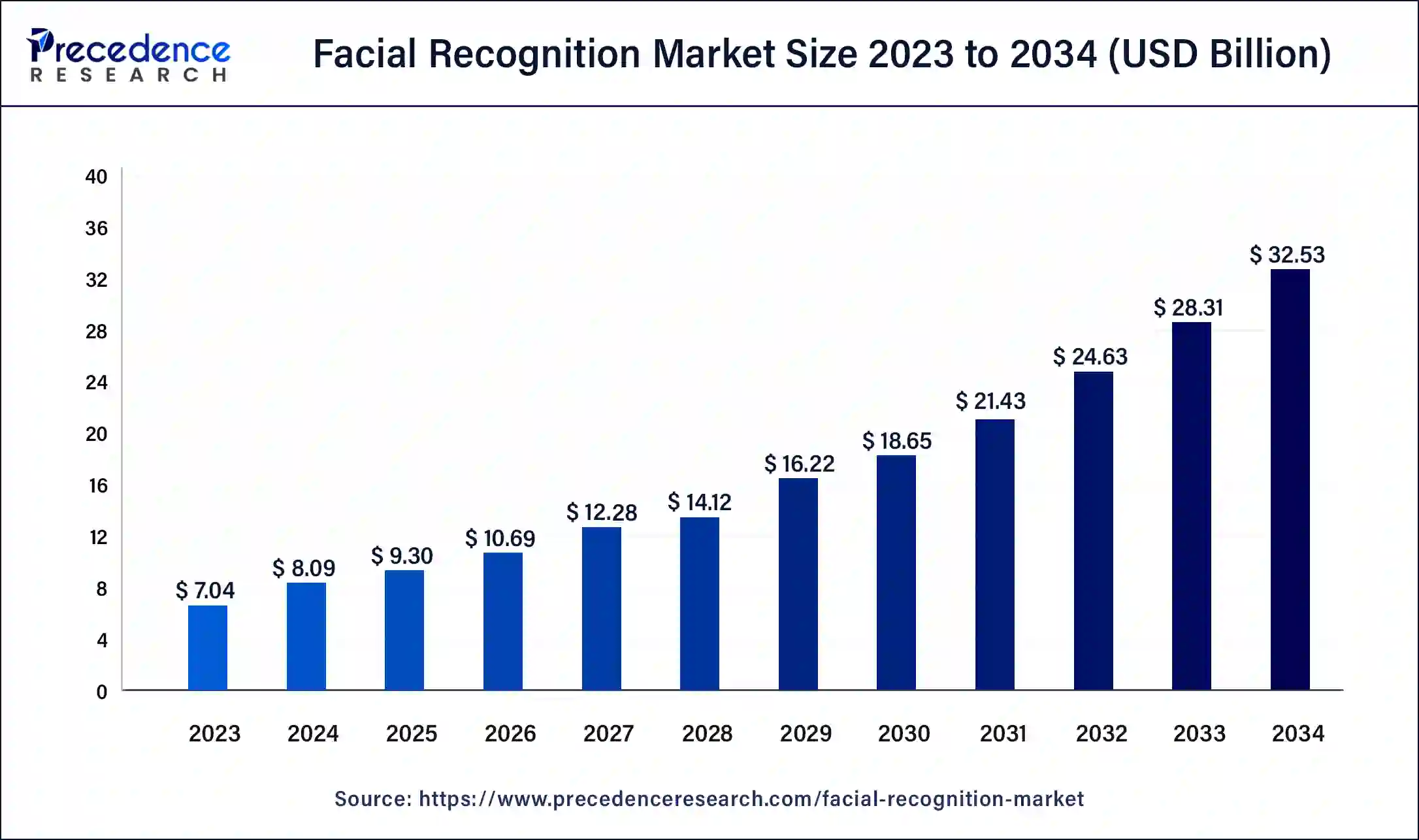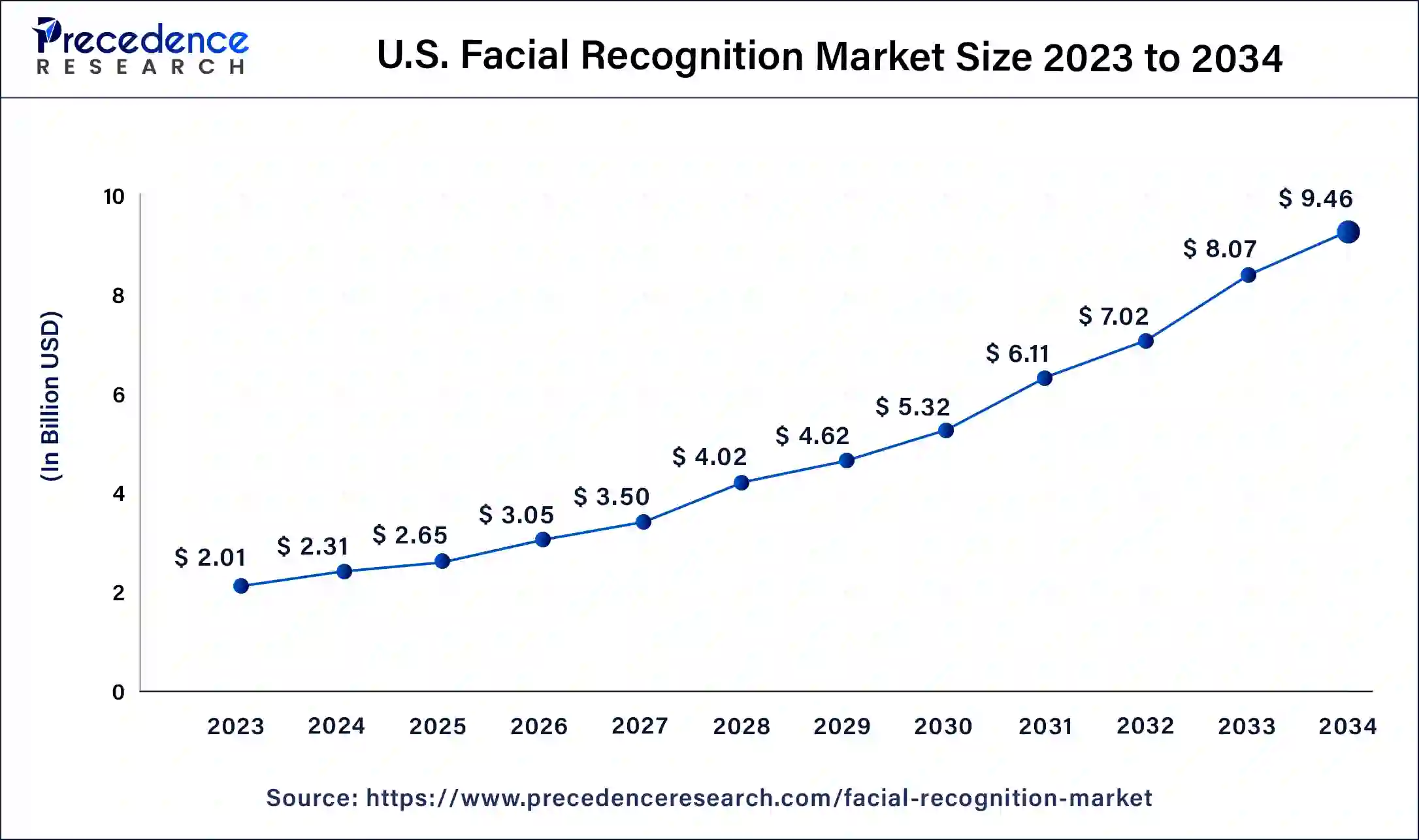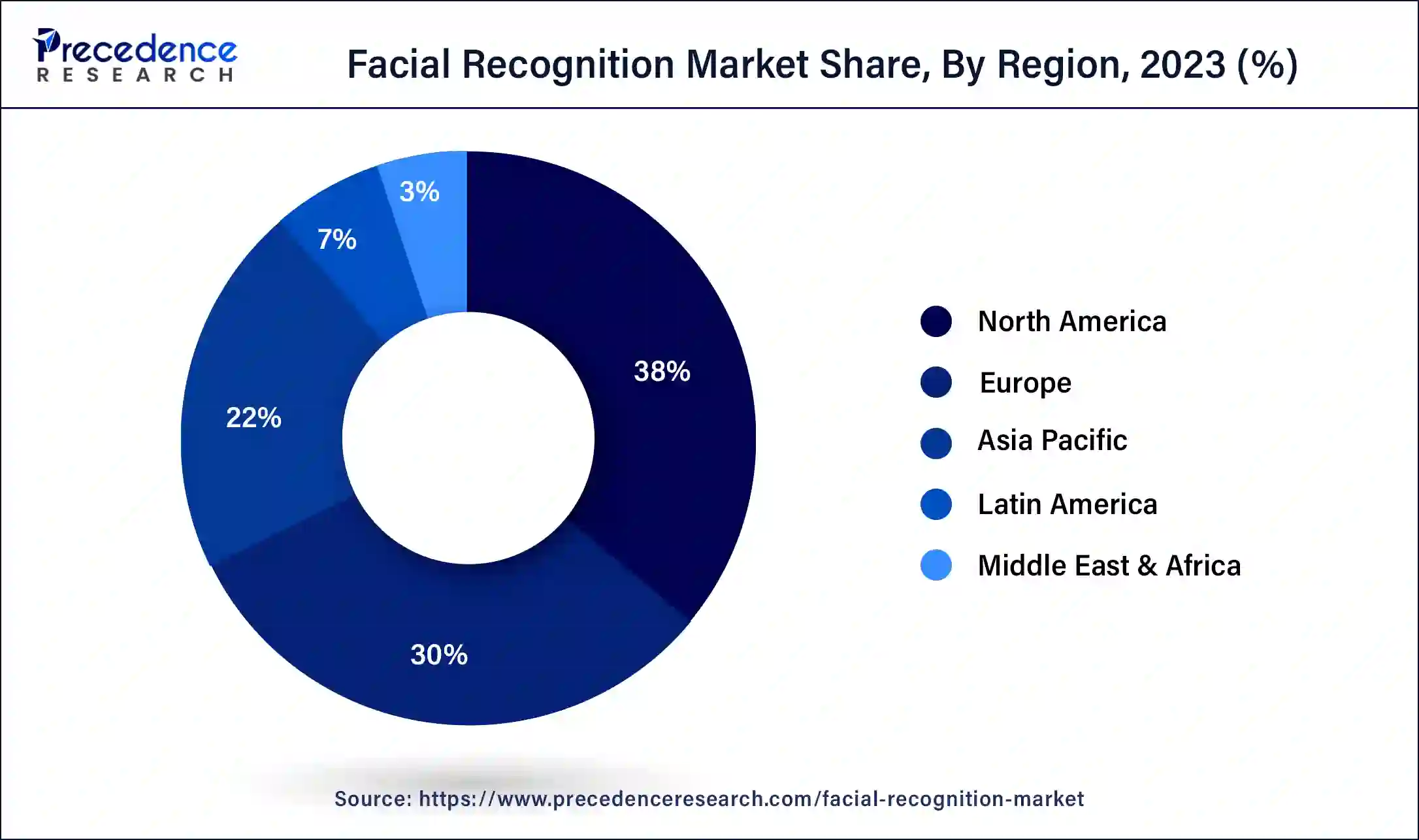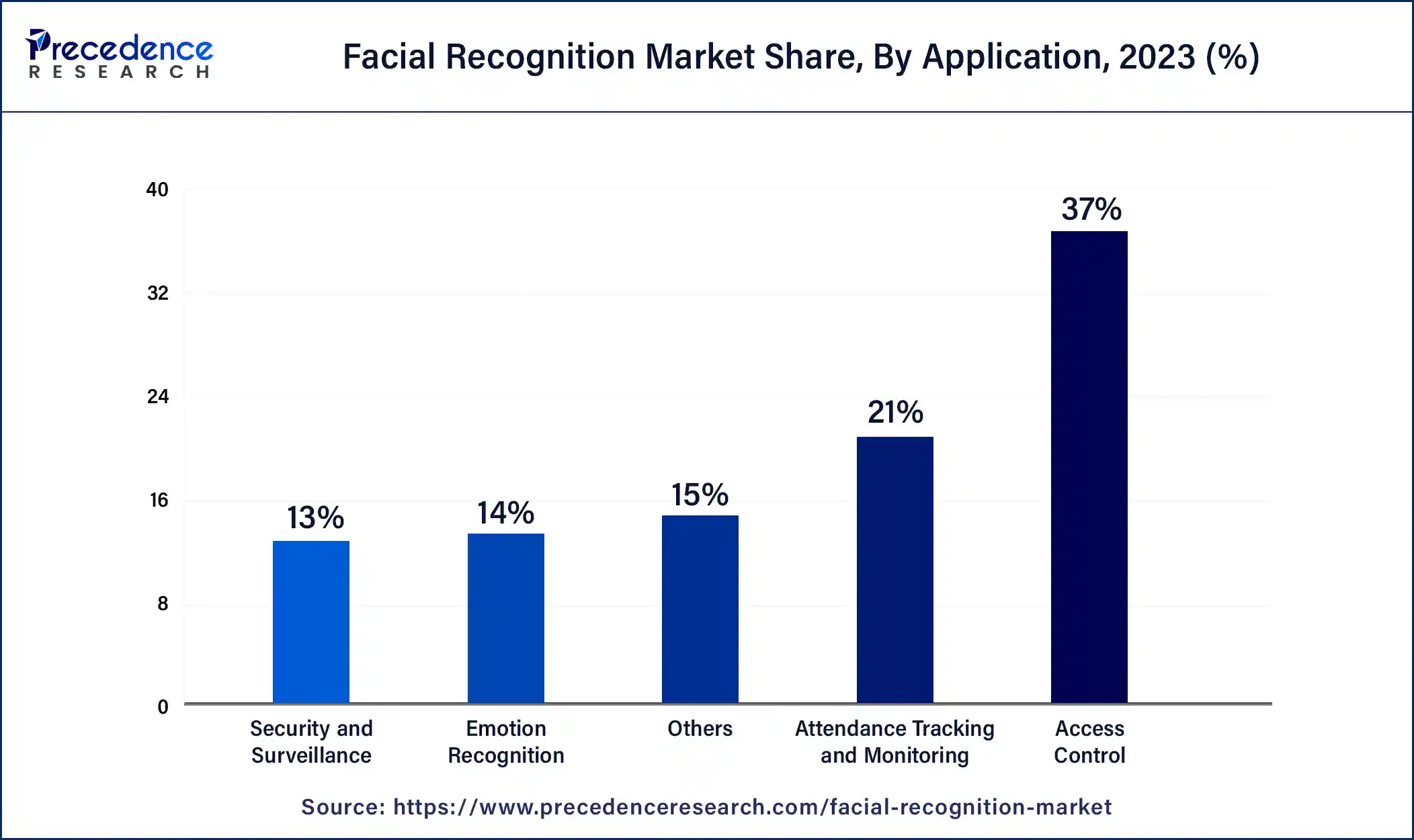October 2024
Facial Recognition Market (By Technology: 2D, 3D, Facial Analytics; By Application: Emotion Recognition, Attendance Tracking and Monitoring, Access Control, Security & Surveillance, Others; By End-User: Retail & E-commerce, Media & Entertainment, BFSI, Automobile & Transportation, Telecom & IT, Government, Healthcare, Others) - Global Industry Analysis, Size, Share, Growth, Trends, Regional Outlook, and Forecast 2024-2034
The global facial recognition market size was USD 7.04 billion in 2023, accounted for USD 8.09 billion in 2024, and is expected to reach around USD 32.53 billion by 2034. The market is expanding at a solid CAGR of 14.93% over the forecast period 2024 to 2034. The North America facial recognition market size was valued at USD 2.68 billion in 2023. The increasing demand for enhanced security technologies from several service sectors drives the growth of the market.

The U.S. facial recognition market size was exhibited at USD 2.01 billion in 2023 and is projected to be worth around USD 9.46 billion by 2034, poised to grow at a CAGR of 15.12% from 2024 to 2034.

North America dominated the market with the largest market share in 2023. The growth of the market is attributed to the rising technological adoption in the various industrial sectors and the growing development in modern technologies like artificial intelligence, machine learning, automation, IoT, sensors, and other technological advancements that drive the growth of the market. The increasing penetration of facial recognition technologies in various end-use industries like retail and e-commerce, hospitality, consumer electronics, banking, hospitality, and others further drives the growth of the facial recognition market in the region.

Asia Pacific is expected to boost market growth during the forecast period. The growth of the facial recognition market is expected to increase due to the rising penetration of technologies into the daily life of the consumer, the rising interest in the technologies, and the faster adoption rate, which are accelerating the growth of the market. The rising penetration of mobile users and the major telecom players adopting facial recognition into their products are also driving the demand for the market. Additionally, the ongoing investment in security technologies such as fingerprint authentication, 3D authentication, and other technologies is boosting the growth of the face recognition market across the region.
Facial recognition is the technology that identifies an individual's identity using algorithms, such as video frames and digital images. This technology falls under the biometric software segment that maps the features of individuals for identity confirmation. Facial recognition technologies are used by several service sectors and personal consumer electronic products such as mobile phones. The rising penetration of facial recognition in various industries, such as retail, e-commerce, healthcare, hospitality, and others, is for security enhancement, which drives the growth of the market.
| Report Coverage | Details |
| Market Size by 2034 | USD 32.53 Billion |
| Market Size in 2023 | USD 7.04 Billion |
| Market Size in 2024 | USD 8.09 Billion |
| Market Growth Rate from 2024 to 2034 | CAGR of 14.93% |
| Largest Market | North America |
| Base Year | 2033 |
| Forecast Period | 2024 to 2034 |
| Segments Covered | Technology, Application, End-User, and Regions |
| Regions Covered | North America, Europe, Asia-Pacific, Latin America, and Middle East & Africa |
The increase in the use of facial recognition in the healthcare industry
The rising adoption of facial recognition by the healthcare industry for several healthcare services is driving the expansion of the facial recognition market. Facial recognition helps identify patients and simplifies the check-in process. It automates the check-in process in hospitals by eliminating or reducing the work and paperwork of hospital workers at the time of check-in. Facial recognition verifies patients and insurance data just by looking at the patients and speeds up the admission process. Facial recognition also helps diagnose various rare genetic diseases.
For instance, Delaware’s Nemours Children’s Hospital deployed facial recognition technologies in clinical practices to identify and diagnose patients with unusual symptoms. Dr. Karen Gripp, one of the hospital's doctors, developed Face2gene, a facial recognition mobile app for detecting unusual symptoms.
High cost
The higher cost of installation of the technologies in the sectors is negatively impacting the growth of the facial recognition market. The higher cost of technology development, such as middleware for large-scale surveillance (MILS) components, deep learning engine (DLE), and smart surveillance engine (SSE), limit the growth of the facial recognition market.
Rising penetration of mobile users
The rising penetration of mobile users around the world is contributing significantly to the growth of the facial recognition market. The integration of facial technologies in mobile phones enhances security options and the identification process. The increasing adoption of facial recognition technologies in several mobile applications like app access, mobile payments, identity verification, and application unlocking.
Furthermore, facial recognition is also adopted by various end-use industrial applications like banking, retail, e-commerce, and healthcare, which drive the growth of the market. The rising investment in research and development technologies in the expansion of digitalization and automation technologies and launches is accelerating the growth of the facial recognition market.
The 3D segment dominated the market with the largest facial recognition market share in 2023. The growth of the segment is attributed to higher performance and accuracy than the other types of authentication processes. 3D facial recognition is also known as the three-dimensional face recognition. It is one of the revolutionary advancements in facial recognition.
The 3D facial recognition system uses the 3D structure of the human face to identify the actual person. 3D facial recognition is used in different industrial services such as finance, aviation, e-commerce, and retail. Various financial sectors, like HSBC banks, started using facial recognition for several banking services such as account access, customer authentication, and others. It is also used to minimize fraudulent attempts to access. In aviation, 3D facial recognition helps in the effortless boarding process. In retail and e-commerce, 3D facial recognition enables a frictionless shopping experience and billing process.
The access control segment held the largest facial recognition market share in 2023. The increasing adoption of face recognition access control in residential and commercial buildings is intended to unlock doors. Digitization and automation in the construction industry are driving the demand for facial recognition systems for residential as well as commercial building purposes. The buildings use face recognition software and hardware to control the access of the houses or commercial properties. Facial recognition access control is the modern alternative to the key, key fobs, and keycards.

There are different types of facial recognition access control, such as photo-based recognition, 3D face recognition, and Iris recognition. Photo-based recognition is the simplest and most widely used type of access control system, and it can be used by normal cameras for face recognition. The facial recognition access control has various benefits, such as being easy to use by any demographic, being hands-free, not being cloned like any other medium like keycards, being remotely enrolled, and minimizing the ongoing cost and other operation expenses that make it affordable for adoption.
The retail and e-commerce segment held the largest share of the facial recognition market in 2023. The rising adoption of facial recognition in retail and e-commerce services is transforming the service by maintaining and streamlining operations, increasing security, and personalizing the customer experience. Security is one of the major concerns in the retail industry; facial recognition helps identify security threats and individuals who are involved in criminal activities with the help of advanced algorithms and real-time analysis. Many of the major retail sectors are involving facial recognition technology to enhance their security. Facial recognition helps in managing the multi-store management in multiple retail locations.
It helps simplify multi-store management systems by leveraging a centralized system that ensures enhanced consumer experience and security measures and enables data analysis technologies in every store. Facial recognition is also transforming the payment process in the retail sector. It redefines the payment experience for both retailers and consumers. It helps in a seamless and timeless payment procedure, eliminating the need for a physical card or cash.
Segments Covered in the Report
By Technology
By Application
By End-User
By Geography
For inquiries regarding discounts, bulk purchases, or customization requests, please contact us at sales@precedenceresearch.com
No cookie-cutter, only authentic analysis – take the 1st step to become a Precedence Research client
October 2024
February 2025
March 2025
December 2024